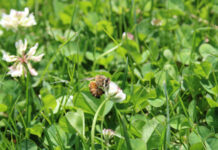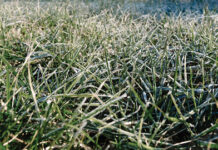 With the first day of Spring approaching, Sod Solutions offers a refresher on lawn care maintenance.
With the first day of Spring approaching, Sod Solutions offers a refresher on lawn care maintenance.
1. Mow lawns at proper heights. The timing for the first mow of the Spring widely varies depending on the area you service. Grasses come out of dormancy differently depending on the environment and temperatures your area encounters. Generally speaking, however, mid-March is about the time to begin the regimen for Spring green-ups and mowing. It’s important to note that the first mow of the Spring shouldn’t take place while warm season grass is dormant.
Mowing heights vary for each grass type, but you should never remove more than a third of the leaf blade from any grass type. If you mow less than this, you may risk scalping the grass. Here’s a guide:
Mowing Height by Grass Type
St. Augustine: Between 2″–4″
Zoysia (fine): Between 0.5″–1.5″
Zoysia (coarse): Between 1″–2″
Bermuda Grass: Between 0.5″–1.5″
Centipede Grass: Between 1.5″–2″
Bluegrass: Between 2.5″–3.5″
Tall Fescue: Between 2.5″–3.5″
For more information, view the Lawn Mowing Guide.
Lastly, a good tip for Spring is to make sure all mower blades are sharpened.
2. Start with the appropriate Spring fertilizer. Spring is one of the most important times of the year to use fertilizer. Warm season grasses are coming out of dormancy, so you will want to promote healthy roots and the return of green leaf blades. We advise that you typically wait until the last frost has hit. If you fertilize a lawn and another frost hits, the grass will go right back into dormancy, and you’ll have a harder time getting it to green up again. This does more harm than good.
With that being said, the date of the last frost varies from location to location. In the Florida Panhandle, for example, grass doesn’t ever go truly dormant and reaches its full green-up in early February (depending on how cold the Winter was). Even then, you won’t want to apply fertilizer until after Easter once the last frost has passed.
Sod University recommends two different options for Spring fertilization: Lawnifi® Foundation, a slow-release granular option that comes in 25 lb. bags and lasts for three months, and our Lawnifi Spring Fertilizer Box, a liquid fertilizer program that includes three bottles of liquid fertilizer that can be applied monthly with a hose-end sprayer.
Next, it’s important to mention that if you service warm season lawns, you may start to notice spots of brown or straw-like grass on some properties while the rest of the lawn comes out of dormancy. This is usually a sign of disease. You don’t want to apply fertilizer to a lawn with disease as the nitrogen in the fertilizer will feed the disease and promote its growth. Apply a systemic fungicide first and then wait several weeks before following with a fertilizer application.
3. Set Up a Spring irrigation schedule. Dormant, warm season turfgrass doesn’t need much water until the active growing season kicks in and grass starts to green up. Once grass starts to green up from Winter dormancy, lawns should be watered with about 1″ of water per week including rainfall. Perform an irrigation audit if you are unsure how much water a lawn is receiving.
4. Control Weeds with a pre- or post-emergent herbicide. Pre-emergents should be applied during the Spring when ground temperatures reach about 55˚F. The exact dates for these applications differ depending on the area you work in, but generally speaking, pre-emergents should be applied between the beginning and middle of March in the Spring.
Apply post-emergent herbicides throughout the Spring as needed to control Summer annual and perennial broadleaf weeds like crabgrass, goosegrass, sandspurs, dallisgrass, dandelion, chickweed, white clover, knotweed, spurge, dollarweed, doveweed and lespedeza.
5. Watch out for insects. If you have clients whose lawns have suffered from insect damage around this time in the past, it’s a good idea to apply a broad spectrum insecticide at this time to prevent them from coming back again.
Some of the most common of insects in the Springtime are white grub worms, chinch bugs, sod webworms, and billbugs. White grub worms can be found in most turfgrasses at this time while chinch bugs are more likely to be spotted in St. Augustine grass, sod webworms in Bermuda grass, and billbugs in zoysia grass.
Sod webworms are typically more of a Summer or Fall pest, however, they can still cause a significant and costly nuisance to lawns located throughout the Southern regions of the U.S. during the Spring season.
6. Prevent disease as temps warm up. As previously mentioned, with warm season lawns, circular brown or yellow spots, also known as spring dead spot, may start to show up as they come out of dormancy. Other potential disease outbreaks include brown patch and gray leaf spot.
If you notice any disease outbreaks, you may need to make applications of a systemic fungicide. Even if you don’t have disease on client properties, it’s still good practice to apply fungicide preventively to keep disease from taking over—especially if the property has had disease in the past around this time.
Systemic fungicide applications should take place before you apply any Spring fertilizer. If you have fungus in a lawn, the nitrogen found in fertilizers oftentimes feeds it and helps it spread. Apply a systemic fungicide and wait a few weeks before applying any fertilizer. Read product labels thoroughly.
7. Look into these options. Here are a few other optional things that can be done to help lawns thrive in the Spring. Before the onset of Summer heat, lawn patchwork and light top dressing with a sand and topsoil mix is a great way to recover any weak areas. Plugs can fill in areas of the lawn with bare spots.
Aerating is also an ideal way to help deliver nutrients and really break up compacted soils. We typically recommend doing this once every couple of years. If you notice thatch that is thicker than 1⁄2″, dethatch in late May.
Want to learn more about achieving great turfgrass? Check out more Sod University tips here and subscribe to our weekly newsletter.
Photo: Sod Solutions
Sod Solutions has helped successfully develop and release to the market over 20 different turfgrass varieties over the past three decades including PalmettoⓇ and CitraBlueⓇ St. Augustine, EMPIREⓇ, CitraZoyⓇ and InnovationⓇ Zoysia and CelebrationⓇ, Latitude 36Ⓡ and NorthBridgeⓇ Bermudagrass. The company is celebrating its 30th anniversary in 2024 and is based in the Charleston, SC area.
For more on turfgrass, see:











![[VIDEO] Dickies®: Discover Workwear That’s Anything But Uniform](https://turfmagazine.com/wp-content/uploads/2023/06/1647663814-4b1a2a7742790a9b1e97a3b963477850192e1d6a9dfba9b07214a77bae25d6e3-d-218x150.jpg)































![[VIDEO] Dickies®: Discover Workwear That’s Anything But Uniform](https://turfmagazine.com/wp-content/uploads/2023/06/1647663814-4b1a2a7742790a9b1e97a3b963477850192e1d6a9dfba9b07214a77bae25d6e3-d-324x160.jpg)